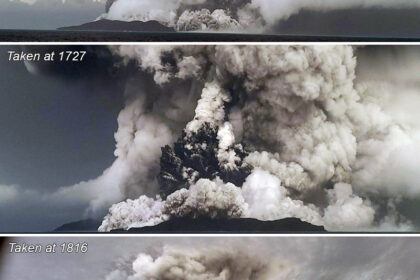Hi readers!
The Environment correspondent of BBC news Matt McGrath reported that:
“El Niño planet-warming weather phase has begun”.
For details: pl. visit
https://www.bbc.com/news/science-environment-65839060
McGrath reported
“A natural weather event known as El Niño has begun in the Pacific Ocean, likely adding heat to a planet already warming under climate change”.
Dear readers, do you remember when I started video blogging (Vlogging), I discussed this phenomenon in the very second vlog in the month of April 2023 (Here is the link: https://youtu.be/Cd1xtSeALjY) saying that the:
season is coming when you will hear this word very frequently hence, it would be imperative to understand the phenomenon to understand what is going to happen. The time has now come, and I hope that you realize what is going to happen?
Just a few words to remind you of the phenomenon.
A pair of words used extensively by meteorologists especially during summer are “El Nino and La Nina.”
What is this phenomenon?
El Niño and La Niña are climate patterns in the Pacific Ocean that can affect weather, wildfires, ecosystem and economies of the entire world.
Warmer or colder than average ocean temperatures in one part of the world can influence weather around the globe and also affect the jet stream.
During normal conditions in the Pacific ocean, trade winds (prevailing easterly winds encircling the Earth near the equator) blow from east to west along the equator, taking warm water from South America towards Asia.
To replace that warm water, cold water rises from the depths: a process called upwelling (ENSO: El Niño-Southern Oscillation) which is a recurring climate pattern involving changes in the temperature of waters in the central and eastern tropical region.
El Niño (Boy) and La Niña (girl): both Spanish words, are two opposing climate patterns that break these normal conditions (The ENSO cycle).
During El Niño, trade winds weaken, warm water is pushed back from east, toward the west coast of the Americas. The warmer waters cause the Pacific jet stream to move south of its neutral position,
(Jet stream predominantly flows east to west over equatorial land masses).
With this shift, areas in the northern U.S. and Canada are dryer and warmer than usual. But in the U.S. Gulf Coast and Southeast, these periods are wetter than usual and have increased flooding.
La Niña has the opposite effect to El Niño during which, trade winds are even stronger than usual, pushing more warmer water than usual toward Asia. Off the west coast of the Americas, upwelling increases, bringing cold, nutrient-rich water to the surface.
These cold waters in the Pacific push the jet stream northward which leads to drought in the southern U.S. and heavy rains and flooding in the Pacific Northwest and Canada.
The whole story is that La Nina and El Nino are two weather patterns which, in combination with Jet stream and trade winds, influence the world weather pattern.
What is the story that Matt McGrath is telling?
It says that what researchers have been predicting since long that El Nino event is building up in the Pacific Ocean.
For months, researchers have been increasingly confident that an El Niño event was set to emerge in the Pacific Ocean is now storming up and will peak at the end of this year in terms of its intensity, and it is quite probable that it will set a new record for global temperatures depending upon how big the El Nino turns out to be.
A big El Niño at the end of this year will probably set a new record for global temperatures in 2024. This natural phenomenon is thus responsible for the most powerful fluctuation in the climate system anywhere on the Earth.
The El Niño Southern Oscillation (ENSO), has three different phases: neutral, cold and hot.
In the neutral state (neither El Niño nor La Niña) trade winds blow east to west across the surface of the tropical Pacific Ocean, bringing warm moist air and warmer surface waters towards the western Pacific and keeping the central Pacific Ocean relatively cool. The thermocline (which is the transition layer between warmer mixed water at the surface and the cooler deep water below) is deeper in the west which means that the warm water will have to go deep down the sea to mix with cold water which is not the case in the east.
The cold phase refers to La Nina: periodic cooling of sea-surface temperatures across the east-central equatorial Pacific. It represents the cold phase of the ENSO cycle and is sometimes referred to as a Pacific cold episode.
The hot phase, called El Niño, occurs every two to seven years during which it sends warm waters from the surface off the coast of South America and spreads it across the ocean pushing significant amounts of hot water towards Asia and thereby causing the atmosphere to heat up.
Record warm years, including 2016: “the world’s hottest on record” usually happen the year after a powerful El Niño event which is currently expected as per BBC report thereby warning us that:
2024 might become the hottest year.
Weather agencies around the world through different criteria determine when this, hot phase will begin?
The first prerequisite for this is the ocean temperature that has to be 0.5o hotter than normal for a month,
atmosphere must be seen responding to this heat, and
there must be evidence that the event is persisting:
the conditions: that have been met in the month of May 2023, obliging the US National Ocean and Atmospheric Administration (NOAA) to issue a statement that, “El Niño conditions are present.”
“Though, the signals are very weak but according to prevailing conditions, it is believed that the signals will intensify,” said a scientist with NOAA.
The researchers believe that this event has an 84% chance of exceeding moderate strength by the end of this year. The reason is that global temperatures are currently hovering around 1.1oC which is above the average for the period from 1850-1900, and could exceed beyond this limit by 0.2oC due to El Nino event which will push the world close to breaking the symbolic 1.5oC: the limit set in Paris Agreement. They also say there is a one in four chance of this event exceeding 2oC at its peak, which is like getting into the territory of a “super El Niño”.
However, breaking this limit temporarily will probably not be seen in the next few years as the human race will see global mean temperature rising as a regular thing in the next 5 to 10 years of time thus giving us hope for the future. These are our new thresholds. And El Niño is proving to be an accelerant on that.
It is very likely that the impacts of the onset of El Niño will lag behind by a few months but will be felt all over the world and will likely include drier weather conditions in Australia and parts of Asia, and potential weakening of the monsoon in India, Southern US states will be wetter in the coming winter whereas drought conditions will be strengthened in Africa which is usually observed during El Nino. From our previous experiences it can be expected that the upcoming El Nino will have a large human and economic cost.
The strong El Niño in 1997-98 cost the world over $5 trillion and around 23,000 deaths caused by storms and floods, and it is very likely that the current El Nino will leave 2016 behind 2024 which will be world’s hottest year.
Conclusion
US scientists confirmed that El Niño had started, and It will likely make 2024 the world’s hottest year,
They fear that it will push the world beyond 1.5oC warming milestone,
It will also affect world weather, potentially bringing drought to Australia, more rain to the southern US, and weakening Indian monsoon,
The event will likely last until next spring, after which its impacts will recede.
These are the new thresholds, and El Niño is proving an accelerant on that.”
So: ladies and gentlemen, be prepared for the event.
Sergio Garcia: Spanish professional golfer once said,
“The Spanish press started calling me El Nino when I was very small. Now I have grown a little. The problem is, when I am 30 years old, we’ll have to come up with another one”.
Sergio Garcia won the British Amateur Championship in 1998 when he was a boy. His intelligence on the golf course led to a nickname, El Niño, that stuck throughout his career, long after he was no longer “the boy”.
That’s all for now dear readers. See you next week. Till then. take care, Bye





